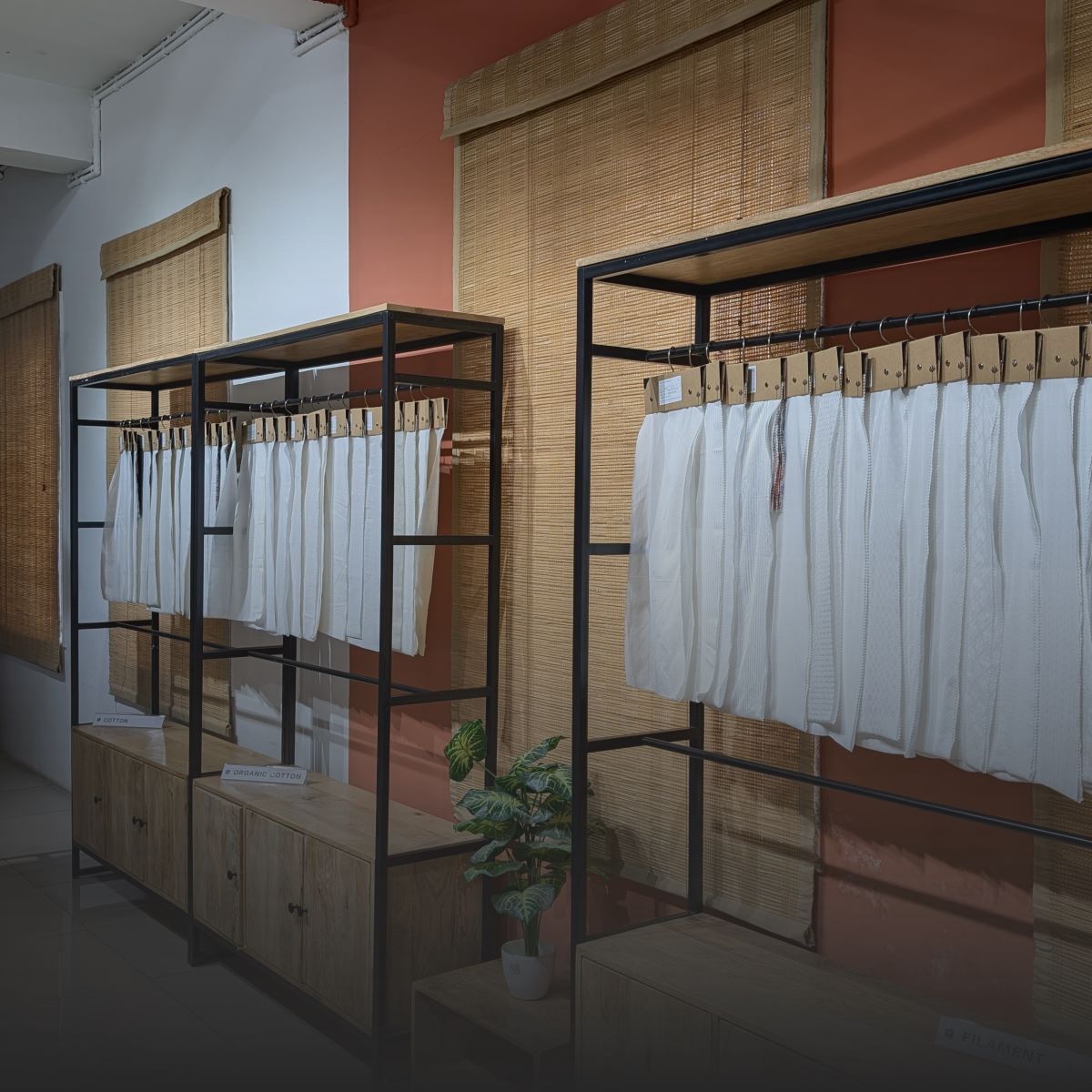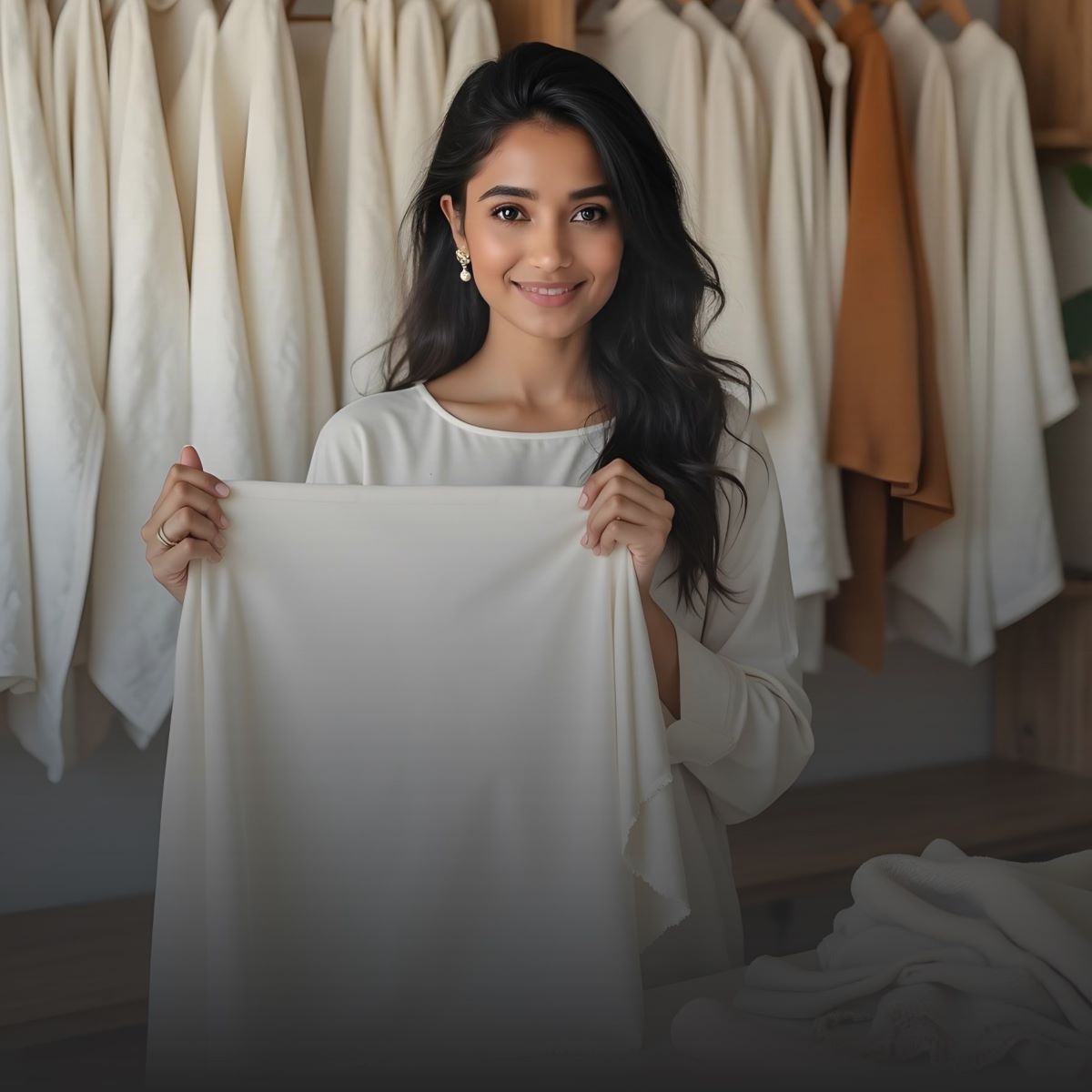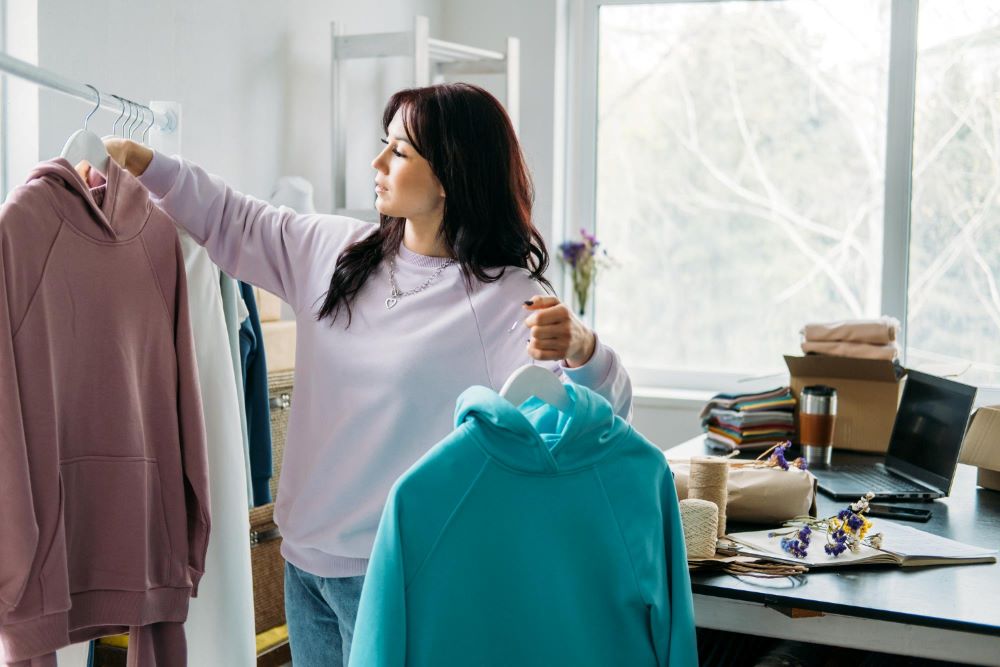Introduction
In the realm of casual comfort and effortless style, cardigans and sweaters undoubtedly hold the top spot in any wardrobe. These versatile garments are essential for layering in cold weather and contribute significantly to showcasing personal style in various regions and climates.
British Army Major General James Brudenell, 7th Earl of Cardigan, popularized the cardigan in the 19th century. For warmth and flexibility, athletes started wearing sweaters in the late 1800s. Both garments evolved from functional outerwear to essential fashion items in various textures and fabrics for every lifestyle. This blog covers cardigans and sweaters' types, fabrics, styles, measurements, and features:
You Can Also Read For More Related Information : Choosing Sweatshirts & Hoodies Based on Fabric: Ultimate Guide to Comfort & Style
Types of Cardigans & Sweaters

There are many cardigans and sweaters, and each is made to do a different job, like keeping you warm, making it easy to layer clothes, or adding texture and style to an outfit. Based on the material and structure, here is a list of the most common types:
Cardigans
Cardigans can be formal and put-together or slouchy and comfortable. They are great for layering and adding depth to an outfit. The way and where they're best worn often depend on the fabric they're made of.
- Wool Cardigan: Wool cardigans are a must-have for cold weather because they keep you warm. These clothes last long, breathe well independently, and are perfect for fall and winter.
- Cotton Cardigan: Cotton cardigans are great for dressing in the spring and early fall because they are light and airy. They are nontoxic, soft, and simple to clean.
- Cashmere Cardigan: Known for being very soft and warm without being too bulky. Cashmere cardigans look great with both dressy casual and business attire.
- Chenille Cardigan: Chenille cardigans are very soft and add a nice touch to cozy outfits thanks to their plush, smooth texture. For sitting or casual winter wear, these are great.
- Lightweight Cardigan: These are great for wearing inside or on cool nights because they are usually made of rayon and cotton. It's simple to put on over tanks or dresses.
- Knitted Cardigan: Knit cardigans add a classic touch with designs like cables or ribs that never go out of style. Bigger knits keep you warm, while smaller knits look more stylish.
- Rayon Cardigan: To give you a polished look with a light feel, rayon cardigans are soft and drapey. Perfect for adding layers at work or a smooth change from day to night.
- Silk Blend Cardigan: Silk mix cardigans are both stylish and comfortable. They have a natural sheen and a smooth finish. Perfect for events or dinner dates.
Sweaters
Depending on the fabric, sweaters can look very different, from sporty to classy. Some are made for brutal winters, and others are just right for cooler AC rooms or mild fall days.
- Fleece Sweater: Because they keep you warm and dry, fleece jackets are great for outdoor activities or cold mornings. Lightweight and useful.
- Cotton Sweater: Cotton sweaters are soft and airy so you can wear them all year. They don't need much care and are great for people with sensitive skin.
- Synthetic Blend Sweater: These sweaters are long-lasting, cheap, and keep their shape well after washing. They are made of polyester or acrylic, which is great for everyday wear.
- Alpaca Sweater: It is hypoallergenic and softer than wool, so alpaca jackets are luxurious and practical. It keeps you warm without making you bulkier.
- Mohair Sweater: With their soft and lightweight feel, mohair sweaters are stylish and warm. Perfect for elegant winter clothes.
- Viscose Sweater: Smooth, smooth, and breathable, viscose sweaters drape wonderfully and feel indulgent against the skin. It's ideal for dressy situations.
-
Terry Sweater: Designed from looped cotton fabric, Terry sweaters are sporty, absorbent, and casual. They're perfect for fitness or a laid-back weekend look.
For More Related Information : Men's Coats and Blazers based on Fabrics and Seasons
Fabrics & Materials

Each Fabric has its own qualities that affect how warm it is, how it feels, and how it looks. This is how they compare:
|
Fabric |
Key Qualities |
Best For |
Care Tips |
|
Wool & Alpaca |
Warm, insulating, moisture-wicking |
Cold climates, winter wear |
Hand wash or dry clean |
|
Cotton & Terry |
Soft, breathable, hypoallergenic |
Spring/fall layering, casual days |
Machine washable |
|
Cashmere & Mohair |
Luxurious, soft, insulating |
Formal wear, cool evenings |
Dry clean only |
|
Chenille & Fleece |
Plush, cozy, texture-rich |
Loungewear, casual outfits |
Machine wash cold, gentle cycle |
|
Silk Blend, Rayon, Viscose |
Lightweight, elegant, drapey |
Workwear, travel, evenings |
Hand wash or dry clean |
|
Synthetic Blends |
Durable, budget-friendly, wrinkle-resistant |
Everyday wear, travel-friendly |
Easy care, machine washable |
Styling Tips For Different Occasions

What you wear says more than words, from business meetings to lunch. Think about how easily Meghan Markle wears a sleek cashmere cardigan to formal events and a breezy cotton sweater for casual events. The fabrics you choose can do the same for you.
|
Occasion |
Recommended Garment |
Ideal Fabric |
Style Tip |
|
Office Look |
Silk-blend or rayon cardigan |
Silk Blend / Rayon |
Pair with structured trousers and minimal jewelry |
|
Casual Day Out |
Cotton sweater |
Cotton |
Tuck into high-rise jeans for a relaxed fit |
|
Winter Layering |
Wool cardigan + fleece sweater |
Wool / Fleece |
Layer under a coat with ankle boots |
|
Evening Event |
Cashmere or mohair sweater |
Cashmere / Mohair |
Elevate with a midi skirt and statement earrings |
|
Travel |
Lightweight or synthetic blend cardigan |
Rayon / Synthetic Blend |
Packs small—add a scarf to complete the look |
Garments By Body Type

The proper fabric and fit will make you feel better and highlight your natural shape, making you seem fashionable in every ensemble.
|
Body Type |
Recommended Garment Style |
Ideal Fabrics |
Why It Works |
|
Pear-shaped |
Cinched waist cardigans |
Knitted / Rayon |
Defines the waist and balances proportions |
|
Apple-shaped |
Flowy, open-front styles |
Silk Blend |
Creates vertical lines for a slimming effect |
|
Hourglass |
Fitted sweaters or wrap cardigans |
Cotton / Cashmere |
Accentuates natural curves |
|
Rectangle-shaped |
Chunky knits and textured styles |
Chenille / Fleece |
Adds volume and dimension |
|
Petite |
Cropped or lightweight cardigans |
Viscose / Cotton |
Doesn’t overwhelm frame, keeps proportions balanced |
|
Tall |
Longline or oversized fits |
Alpaca / Mohair |
Enhances height with flowy silhouette |
Trending Garments: Winter 2025 (USA)

Fashion is embracing timeless beauty and easy layering in winter. From celebrity street style to runway-approved materials, comfy shapes that make a statement are the focus. Every season and climate has a fashionable look, from the wintry Northeast to the breezy California coast.
Look at celebrities like Hailey Bieber, who is often seen wearing a wool sweater that is too big on her over sleek boots, or Zendaya, who looks great in mohair textures in bright colors.
Gigi Hadid likes to wear knitted co-ord sets when she's not working, and Emma Chamberlain likes to layer light cardigans, which are great for L.A.'s uncertain winters.
Even fashion stars like Rihanna have been seen wearing warm alpaca and wool basics that are also good for the environment. These are some of the things that people want in the US right now:
|
Trend |
Description |
Fabric |
Where It’s Popular |
|
Oversized Wool Cardigans |
Worn with turtlenecks and boots |
Wool |
Northeast & Midwest |
|
Chenille & Mohair Sweaters |
Cozy textures in bold colors |
Chenille / Mohair |
West Coast & fashion hubs |
|
Layered Lightweight Cardigans |
Perfect for layering over tanks |
Rayon / Viscose |
California, Southern states |
|
Alpaca & Fleece Sweaters |
Eco-conscious, soft, and warm |
Alpaca / Fleece |
Pacific Northwest & Rockies |
|
Knitted Matching Sets |
Coordinated cardigan and skirt combos |
Cotton / Knits |
NYC, Chicago, LA |
These garments embody the season's aesthetic while addressing regional climate needs and lifestyle trends — providing a compelling reason for everyone to layer up in style.
Measurement Table According To Standard Size Chart (Women)
|
Size |
Bust (in) |
Waist (in) |
Hip (in) |
US Size |
|
XS |
31–32 |
24–25 |
33–34 |
0–2 |
|
S |
33–34 |
26–27 |
35–36 |
4–6 |
|
M |
35–36 |
28–29 |
37–38 |
8–10 |
|
L |
37–39 |
30–32 |
39–41 |
12–14 |
|
XL |
40–42 |
33–35 |
42–44 |
16–18 |
|
XXL |
43–45 |
36–38 |
45–47 |
20–22 |
Note: These are just general rules. For the best fit, always check the brand's size charts.
How To Take Your Measurements

Knowing your exact measurements is essential for getting the best fit, especially when shopping online or having tailored clothes. How to do it right:
- Bust: Get the measuring tape and wrap it around the most significant part of your bust. Make sure it stays straight on the floor. Stand up straight; don't hold your breath.
- Waist: To find your natural waist, look for the narrowest body part, usually above your belly button. Keep your back straight, and don't pull too hard when you measure.
- Hips: Find the most significant part of your hips and buttocks. Make sure your feet are close together and the tape is straight around.
-
Length (not required for tops and cardigans): From where your neck and shoulder meet at the top of your shoulder, measure down to the length of the skirt you want to wear.
Pro Tips:
- Use a flexible measuring tape for best accuracy.
- Wear light or fitted clothing when measuring.
- Measure in front of a mirror or have someone assist you for consistency.
Conclusion
When it comes to fashion, picking the right jacket or sweater isn't just about how warm it is; it's also about how the fabric fits and feels. The fabric you choose makes a huge difference. Soft viscose is excellent for regular wear, and alpaca is luxurious and classy for winter. Adding cardigans and sweaters to your outfit is a great way to stay warm and stylish, whether you're doing it for function or style.
Last words: Don't be afraid to try new shapes or mix different materials. Each cloth gives your outfit its unique look and feel.
For More Related Information : Men's Coat and Blazers Based on Fitness and Style
We'd love to hear from you! Share your favourite cardigan or sweater styles in the comments or FAQs section below.
Faqs: Cardigans & Sweaters Based On Fabric
1. What's The Warmest Fabric For Winter Cardigans And Sweaters?
Wool and alpaca are the leading competitors for winter warmth. Wool is a natural insulator that holds heat while allowing your skin to breathe, making it great for frigid temperatures. Alpaca wool is softer, lighter, and warmer than sheep's wool. It also lacks lanolin, making it a hypoallergenic option for sensitive skin. Both fabrics are ideal for layering in colder regions while remaining trendy.
2. Can I Machine Wash Cashmere Or Mohair Sweaters?
While throwing everything in the washing machine is tempting, cashmere and mohair require special care. These luscious fibers are fragile and prone to shrinking or losing shape. It's recommended to hand wash them in cold water with a gentle, wool-safe detergent. Avoid wringing or twisting; gently press the water out and lay flat to dry. If in doubt, dry cleaning is the safest technique to extend the life of these high-end items.
3. Which Cardigan Fabric Is Best For A Professional Or Office Look?
Cardigans consisting of silk blends, rayon or fine cotton knits are ideal for business use. These fabrics have a polished, crisp drape that looks great with trousers, pencil skirts, and dresses. Silk blends provide a hint of gloss and elegance without being overly flashy, whilst rayon provides a lightweight, breathable construction that suits all body types. They stack well under blazers or structured jackets, ensuring a professional, put-together appearance.
4. What’s A Good Travel-Friendly Cardigan Or Sweater Fabric?
Comfort and ease of use are very important when moving. Synthetic blends and lightweight rayon are great options because they don't wrinkle, are easy to fold, and stay in good shape even after being in a bag for a long time. They dry quickly too, which makes them great for long trips. You can dress them up or down based on the event, so look for styles that are neutral in color and have simple designs.
5. Are Fleece Sweaters An Eco-Friendly Choice?
Yes, modern fleece sweaters can be surprisingly eco-friendly. Many brands now make fleece fabric from recycled polyester, which is made from plastic bottles. This helps cut down on trash that ends up in landfills. These environmentally friendly fleece options keep you warm, wick away moisture, and feel soft without hurting the earth. Always look at the label or brand's sustainability methods to be sure.
We also happen to be a magnet for suggestions, and would love to catch yours….throw us yours on hello@fabriclore.com




